HERE’S How Long it Takes to Learn to Surf: Beginner to Advanced
When asking about learning to surf, the common answer is that it is very difficult, but this does not really help you if you really want a clear picture of just how hard it is and how long it might take.
The difficulty of surfing is connected with the time taken to learn to surf, with lots of beginners and would-be surfers eager to know just how much time they should expect to invest in surfing before they can really learn.
So, how long does it take to learn to surf?
- 30 minutes: stand up on a learner surfboard in the shallows
- <2 hours: paddle for and catch a whitewater wave
- 30 hours: paddle on your board without falling off
- 60 hours: duck dive under oncoming waves
- 120 hours+: ride along the face of an unbroken or ‘green’ wave
- 150 hours+: ride green waves, paddle out and be competent in the surf
Note that the above estimates are all based on the amount of time you spend in the surf, where you have the right learner surfboard, are surfing at a learner spot and being of a moderate level of physical fitness.
On a big board, you could stand up on a wave in the shallows after a couple of waves. However, expect to spend significantly more time to be able to ride a whitewater wave solo; riding along the face could take anywhere from 120-150 hours of time in the waves.
To add to the above, there are many more factors to consider, and points to learn, as we’ll look at below in more detail to give you a better idea of your own progress and expected timeline for learner surfer progression.
Stages of Learning to Surf: Basics
The main point here is to understand what it means to actually learn to surf. There is a whole range of abilities in the learn to surf category so below I’ve included each stage in order with an idea of how long it might take for you to get there.
Riding Whitewater Waves in the Shallows (First-timer)
The first thing all learner surfers will do is to try and ride the whitewater waves in the shallows. These waves break in anywhere from knee to chest-depth water and are therefore a friendly and playful option to start.
These waves are also the first waves you will come across when trying to venture out into the surf.
If you have a big board that is ideal for learning, generally a soft-top foam surfboard that is about 2 feet longer than you are tall, then you could catch and ride a few of these waves in your first few attempts.
Standing up on a surfboard is never easy the first time but many beginners manage to do it when they are on the right board.
In fact, these are the kind of waves that surf schools generally teach their students in because they are so well-suited to learning in.
Riding Whitewater Waves Further Out (Beginner)
After a few more sessions, you will then want to ride whitewater waves a little further from the shore.
This will be once you have gained a bit more confidence in the sea and can do almost all of the ‘functional’ bits of surfing, namely paddling, sitting up on your board, duck diving and standing up.
Paddling
Paddling on a surfboard is a heck of a lot harder than it looks. Surfboards are wobbly when in the water and can really take a long time to get used to.
Not only is the sea moving constantly but you have other obstacles like oncoming waves and other surfers to negotiate, so expect to be paddling in lots of different directions when learning to surf!
You will also need to be able to paddle to catch a wave at the right time, so going from sitting on your board to paddling in the opposite direction can take some practice.
For this reason, it will usually take anywhere from 20-50 hours in the surf before you are able to paddle confidently on a surfboard.
The bigger the board, the easier it is to paddle, so factor that in, too. Just remember that you can always keep practising in the shallows if you are struggling with paddling and it will get easier.
Sitting Up on Your Surfboard
Along with paddling, sitting up on a surfboard is a seriously tricky thing to learn considering how easy it sounds.
I remember it taking me many months of going surfing before I was able to sit up on my board confidently.
It’s useful to sit up on a surfboard to give your chest and lungs a break from all the paddling, which can be quite tiring and uncomfortable at first.
Sitting up is also extremely helpful in terms of having more visibility as you are higher above the surface of the waves so can see oncoming waves sooner and more clearly.
Expect this seemingly easy part of surfing to take you 50-80 hours to learn properly, although it is much harder on smaller boards, so allow for that if you are trying to learn to surf on a board that is smaller than recommended.
Duck Diving
Duck diving is so-named because it was what surfers do to get under an oncoming wave that has already broken.
They push their board down and, just like a duck diving beneath the surface of water, go down under the oncoming wave to avoid the impact.
The duckdive is an essential component of any surf session as there will almost always be a broken wave coming towards you as you are paddling out; fail to duck dive and you will feel the full force of the wave and get pushed back towards shore!
Expect it to take about 50 hours of surfing to be able to duck dive properly. This is because it is a technique that involves balance, timing, and links in with paddling. It’s also almost impossible to duck dive some of the bigger learner surfboards, so you will need to look at doing an eskimo roll instead if you are on a longboard or thick foam board.
To see more on how to duck dive, ‘How to Rip’ over on YouTube have a great step-by-step video on this, included below.
Standing Up
Once you’ve learned how to paddle past a few waves closer to shore, you’ll be ready then to stand up on the waves you’re trying to catch.
Standing up on any wave is probably the hardest part of surfing. It is a movement that is unique to surfing and really takes a long time to get used to.
However, for just standing up on broken whitewater waves, you could figure out how to do this down in a fairly short amount of time, but the problem is that you have to paddle and duck dive first!
With that in mind, expect it to still take you around 20-50 hours of surfing to be able to stand up on broken white water waves a bit further offshore.
You can also start to get some feeling for how to balance while riding your surfboard at this point. However, the balance involved in just going straight to the beach is quite different to the more advanced parts of riding an unbroken wave.
Obviously, the more waves you catch, the quicker this will be; but don’t expect to be able to catch lots of waves when you first start out!
It all gets easier and standing up on a surfboard on a broken wave is no exception. It’s also a lot easier than the take-off needed for an unbroken wave, as we’ll look at in the next section.
Note on the Fundamentals of Surfing
Please remember that, although the points above look and sound easy, they are not easy when you are doing them out in the sea with waves and people around.
It is with this in mind that you should expect to take a while to learn the fundamentals of surfing closer to shore.
Trying to skip ahead and ride unbroken waves before you are ready is not only dangerous for you but also for others out in the surf.
If you cannot confidently do all of the points above, you are likely to be a risk to yourself and others out in the surf.
This is because these fundamentals help you not only to navigate your way to catch better waves but also to control your surfboard, which can be like a weapon if you are not careful.
There are often accidents in the surf with learners who cannot control their surfboard and who let their boards fly wildly out behind them and from under them in the sea.
These boards can easily knock someone else unconscious, or even worse, so take the points above as a serious step in your surfing progression and don’t be in too much of a hurry to get out and catch some bigger waves!
Riding Unbroken Waves (Intermediate)
After getting through the early days of paddling, duck diving and catching a few unbroken waves, you will then want to progress to the next and level of surfing, which is riding unbroken waves.
Remember that you will need to take the time to get to grips with the fundamentals of surfing above before you are truly ready for this since you will be a danger to others out in the surf if you cannot.
Take-off
When you can paddle out and duck dive under waves, the next step is then to take off on a wave that has not broken.
The difference between a take-off and simply standing up on your board is that a take-off means rolling down the face of the wave.
This is therefore getting into the realm of what most people consider truly learning to surf.
Because you can only take-off at a very specific time on any given wave, taking off is something that you will need to practise relentlessly before you are able to do it.
To learn to take off, you will be able to paddle confidently into the right wave, know exactly where you need to be and also when to start the movement.
It also needs a couple of seconds to get up to your feet to start your ride, so you will have to learn to anticipate the exact moment when you need to do this.
Therefore, to learn to take off on an unbroken wave, expect to spend around 80-120 hours in the surf at most spots before you can do this confidently.
Again, this depends on the kind of board you are riding, as well as the kind of waves you are trying to surf.
Learning at gentle beach breaks or point breaks without crowds could mean that you can do this in less time, but it’s still a real skill and takes a lot of practice.
You need to get the muscle-memory right from the hours of repetitive practice, as well as your choice of waves.
Not every wave will let you ride it as some just shut down and dump the moment you take off, so getting good at the take-off usually takes a long time because wave selection and timing are so crucial, which also take a long time to master themselves.
Riding Along a Wave
So, you might have thought that taking off on an unbroken wave was the end of the journey but, in reality, it’s really just the beginning.
The next step you’ll want to try and master is riding along a wave, for which there are two main ways to do this:
- Frontisde
- Backside
So, let’s now consider how long it will take you to get to grips with these aspects of surfing.
Surfing Frontside or Front-hand
Riding a wave frontside means going along a wave with your chest and face facing the breaking wave with your back to the shore.
You can do this in a regular stance, left foot forward, or goofy, right foot forward; it doesn’t make a difference as long as you start to notice which feels more natural for you and go with that.
Learning to ride along an unbroken wave frontside will take a good while, probably somewhere in the 120-200 hours of time spent surfing rage.
This is because this part of surfing progression needs you to be able to catch just the right wave so that you can take-off easily and that has a wave face for you to ride or trim along.
Getting all these points just right can take a long time at first so expect this one to be something that you will experience a good way down the road in terms of your learn to surf journey.
On top of that, you will need to learn to pump the board for speed, as well as start to read the waves. These points combine muscle memory, balance and general know-how that can only be acquired from many hours of practice out in the surf.
Surfing Backside or Backhand
Although surfing a wave backside or backhand may sound like just the same thing as frontside, most surfers will give this significantly more difficult and that it may take double the time to learn when compared to frontside riding.
Drawing on my own experience of learning to ride a wave backhand, this felt alien for a long time. It was almost like learning to write with the other hand. All three learning and muscle memory gained from learning frontside went out the window as soon as I tried learning to ride a wave the other way.
The limited vision and the unfamiliar balance required made backhand wave riding particularly challenging for me.
With this in mind, to learn to surf waves backhand, expect to add on an extra 50% again to the time taken to learn frontside wave riding, so approximately 240-400 hours of surfing.
Be mindful that you will be having a lot of fun at this point anyway so learning this part of surfing, although long, won’t feel as taxing as some of the other parts.
To speed up the process, you could focus on deliberately catching more backhand waves than frontside waves to make up for the extra time needed.
Maneuvers (Advanced)
Except for the air, it’s impossible to say how long each of these may take you to learn as they are so many factors and, depending on why you’re learning to surf, you may never want to this far into surfing techniques.
One thing is for sure, though: these maneuvers will only come after you’ve got to grips with ask the earlier point in this article.
It’s also fair to say that these will need several 100 more hours of surfing time to learn on top of the points listed in the previous sections above.
Bottom turn
This is a deceptively hard maneuver to get to grips with but, as they say, is the cornerstone for all advanced surfing.
Without a good bottom turn, there is no advanced surfing!
To do this, you will need to take off on a good quality wave and start to feel exactly when the timing is right.
Using hands and bending your knees is crucial, as is timing.
A bottom turn sets a surfer up for the rest of the wave so this is a fundamental part of more advanced surfing.
A tip I’ve seen pro surfers mention for a good bottom turn is to wait an extra second after you think it’s time to turn. This is easier said than done but, when I’ve done it, it always feels much better, and faster!
Floater
This is where a surfer rides along the lip of a breaking wave and ‘floats’ down with it as it breaks.
It was one of the earliest moves I performed and the first few times were definitely by accident but felt amazing!
Doing this backhand is particularly difficult early on.
Off the top
This is where a surfer drives up to the top of the wave and snaps their board back down towards the bottom of the wave.
This is a prime example of a maneuver that can only be done with a good bottom turn as, without one, you will not have the speed to get to the top.
Another variation of this is an ‘off the lip’, which is the same but a little more crucial and closer to the lip of the breaking wave.
You might, like me, find this easier on your backhand as the shift in balance needed feels more natural here.
Perhaps this is because of the vision of having your head looking down the wave through the turn, but it certainly feels easier than doing this frontside.
The off the top also needs steeper waves and shorter boards, so forget this one if you prefer to stay with a longboard.
Cutback
A cut back is a swooping turn that is used to do almost a U-turn out on the shoulder of the wave to get back to the breaking part for more speed.
Masters of the cutback include surfing legends Tom Curren, Kelly Slater and Taylor Knox, among others; watching clips of them online can give you a great insight on how to do this.
Again, you might find this maneuver easier on your backhand as you can face down towards where you want to go and see it.
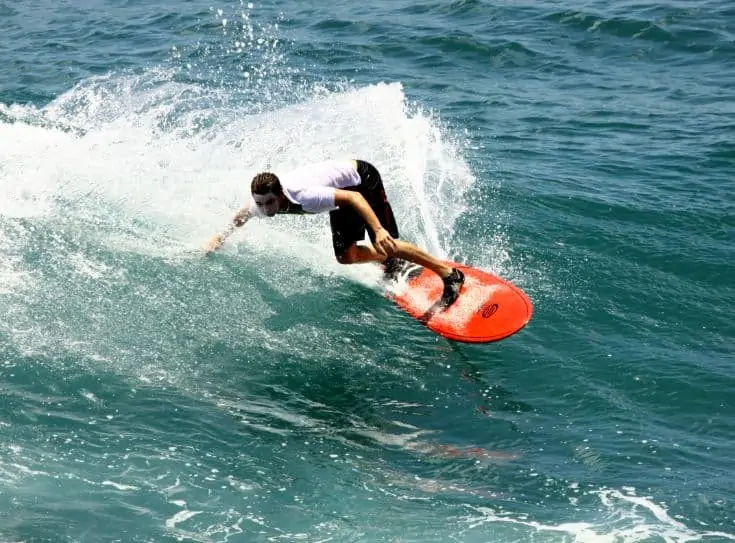
Airs
The air in surfing is one of the most recent maneuvers, probably because it is such a hard thing to do!
To give you an idea of just how hard these are, in the 1980s, when 1989 World Champion Martin Potter first started doing aerial maneuvers in competitions, several other pro surfers led a campaign for judges to ignore airs in their scoring criteria. This was really because the other surfers couldn’t perform this maneuver and were afraid of being made to look inferior; contrast this with today and a professional surgery who can’t do an air probably doesn’t exist.
Although the surfing aerial has been around since the 80s, they have exploded in popularity in the last 10-15 years due to equipment and general advances in the level of pro surfing.
Expect it to take you 1000s of hours of surfing to be able to land an air on your surfboard.
You might land a surfing air sooner if you skateboard and can do ollies and similar tricks.
Airs also require steep, powerful waves so it also depends on your local conditions.
I can say that I can’t do airs so will save giving you tips here!
Your Surfing Situation
To give proper context for how long learning to surf might take for you, it really needs you to also think about your own surfing situation.
The main factors to consider are listed below and will either speed up or slow down your learning depending on how each point relates to your situation.
Frequency
The more often you go surfing, the faster you will learn.
If you can, get in the surf regularly to build on what you’re learning and keep improving.
This may not be possible but I know that when I was learning, I improved more on a surf holiday in a few weeks than many months previously of just going a couple of times a week.
Try to go surfing in the right conditions for you at that time.
Types of Waves You Surf
The time taken to learn also changes depending on the type of excess that you have to surf in your chosen area.
If you have lots of spots for different abilities, then you can likely choose the right ones at the right time.
As mentioned previously, paddling out in advanced surf spots without being ready is not only dangerous but will probably just slow you down and put you off surfing.
I’d also advise against crowded spots early on as this likely scare you and slow down your progression.
Fitness
Maintain a good level of physical fitness out of the surf so that this does not get in the way of your surfing improvement.
Any of the usual types of exercise are good.
Swimming, running, some weights and yoga should really help you to keep up your fitness but going surfing is also a great workout.
Flexibility
Doing anything you can to stay supple and flexible will help you to learn to surf more quickly. This is particularly relevant if you’ll be learning in colder water since the cold had a tendency to make things tighter and me difficult.
Remember to also check out my thorough guide for tips on cold water surfing to keep your progress on track!
Weather
You may also need to factor in the water as this can slow you down.
The seasonal changes in temperature can mean that the cold can stop you from surfing if you don’t have the right kind of wetsuit. It also takes a while to get used to surfing in the cold so don’t expect that to be easy. Winter surfing slows down even the next surfers so allow for this, too.
You may also find that your local area has a limited swell window. Some parts of the world have a season when there are waves almost every day that then leads into another when it can be flat for weeks on end.
Remember to make the most of your local conditions as and when you can since you never know when the next swell is coming your way!
How long did it take you to learn to surf?
It took me around 10 months of surfing a few times a week to stand up and ride along a ‘green’ wave. However, I was using too short of a board and started when it got cold (autumn), both of which slowed my progress.
Either way, it’s not an overnight thing so take your time with it.
If I were to learn surfing again today, I would go for a much bigger board and buy a soft-top one at that. I’d also think about starting in the early summer to be able to get in the warm water with longer days more often, although waves are smaller.
Be sure to check out the best beginner surfboard brands in my dedicated guide!
Related Question
How many surf lessons do you need? One two-hour surf lesson is usually enough for most people to get the basics and an idea of how to surf and the techniques. After that, you can buy your own gear and try alone, or go back for more lessons – it really depends on your comfort level.
The main factor in learning to surf is really how often you go and how much you want to learn, as well as having the right board. If you go often, try hard and have good equipment, you will learn on your own after an initial surf lesson.



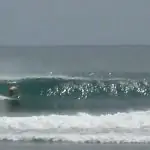
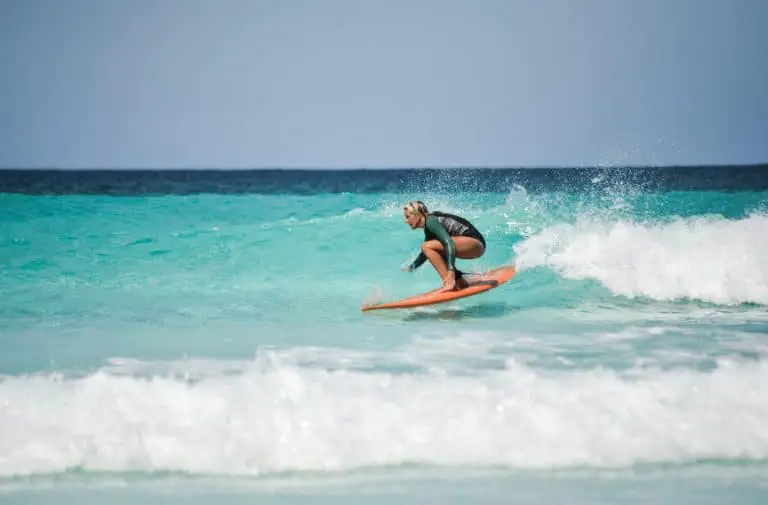
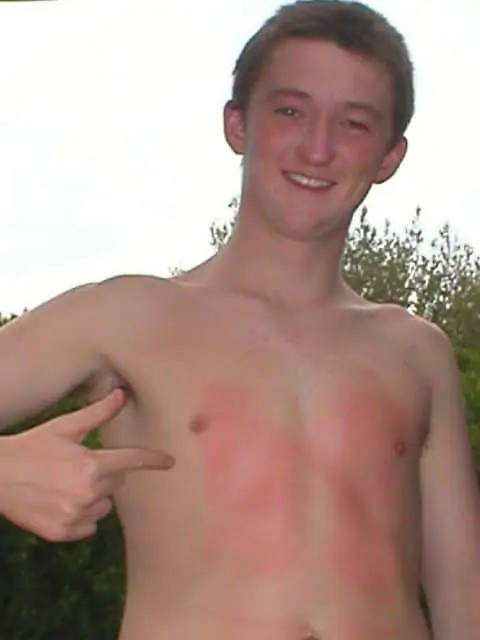
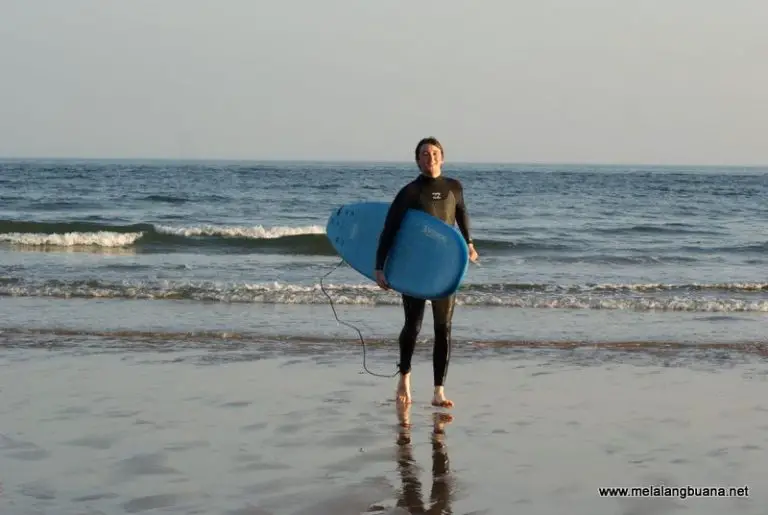
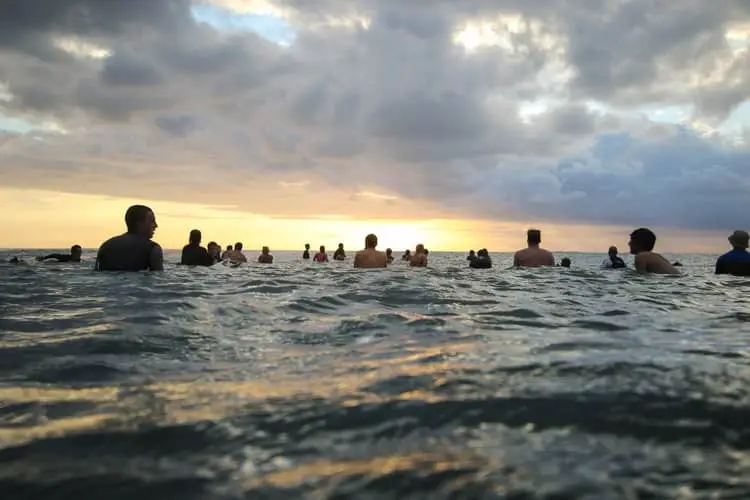
One Comment
Comments are closed.